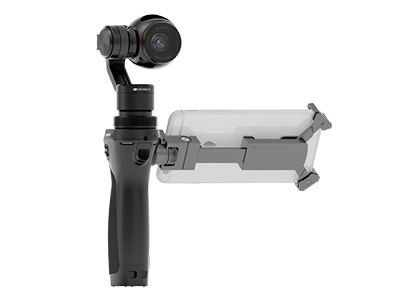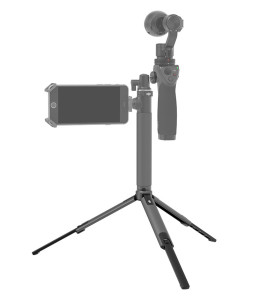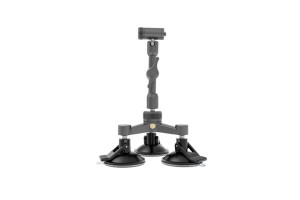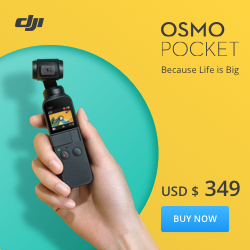The DJI Osmo, which is a standalone 4K camera with a 3-axis gimbal in a neat handheld package has arrived. One of the prototypes of this device was shown off at CES in January in Vegas. It has since been tweaked and changed quite a bit. To see the Osmo Unboxing and Sample Footage shot with the Osmo see the end of the article.
What can this bad-boy do? First there are two parts to the Osmo. The camera and the handle. Let’s take a look at the camera first. The Osmo camera uses the Sony Exmor R CMOS 1/2.3” sensor we know and love from the Inspire 1’s camera. It will feature a non-fisheye warped lens similar to the Inspire 1’s X3. The Osmo X3 camera has been mechanically changed to be better suited for handheld use. I’m guessing that means a few measure to increase robustness and durability as the camera on the Osmo will get bumped harder and more frequently than on an aerial platform.
The gimbal has also been modified. It enables the option to be locked and flattened. The orientation of the tilt motor was changed as well as other smaller changes. The settings for the gimbal and camera can be changed in the DJI GO App. Phantom 3 and Inspire 1 pilots know this app from flying their drones. In the app, you will be able to change the gimbal settings/profiles, follow modes and control stick settings.
If you already own an Inspire 1 you will be able to use your Inspire 1’s X3 camera and gimbal with the Osmo. The X3 camera from the Osmo is also compatible with the Inspire 1. Pricing and availability of the Handle only are TBA. The Inspire 1 camera will need a firmware update through the DJI GO App and then it will be ready for use. The smartphone doesn’t have to be mounted in the mobile mount on the handle. It can be operated from anywhere up to 25m (82 ft) from the device. A fully charged battery will get you 60 minutes of footage or 6 hours of standby time. The included battery charger will charge the battery in another 60 minutes. The device is not waterproof.
You get an ISO range of 100-3200 for video and 100-1600 for photos. Shutter Speed settings range from 8s – 1/8000s. You can also capture exposures up to 30seconds while the camera is in M (Manuel) mode. The image size will be 4000×3000 pixels. The normal photo modes are available such as:
- Single Shot
- Burst mode (3/5/7 shots)
- AEB (Auto Exposure Bracketing)
- 3/5 bracketed frames
- Interval
- Timelapse
- Auto Panorama (where the camera will move on its own to capture the perfect panorama)
- Selfie Panorama (now you never have to miss being in your own pano’s)
The video resolutions featured: (note the 120fps 1080p resolution used for the built in “slow motion” mode)
UHD 4K (4096 x 2160) 24/25p
UHD 4K (3840 x 2160) 24/25/30p
2.7K (2704 x 1520) 24/25/30p
FHD: 1920 x 1080 24/25/30/48/50/60/120p
HD: 1280 x 720 24/25/30/48/50/60p
Maximum Video Bitrate: 60Mbps
You will need a fast Class 10 or UHS-1 certified microSD card to keep up with the 4K video being written to the card. The maximum capacity microSD card accepted is 64GB. There is a built-in microphone to capture Two channel 48 KHz AAC audio.
A few images of the new Osmo:
A few accessories were also launched today:
The extension handle: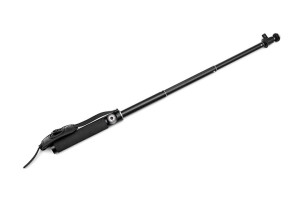 The universal mount: (Allows to attach external microphones or LED light panels)
The universal mount: (Allows to attach external microphones or LED light panels) The bike handle bar mount:
The bike handle bar mount: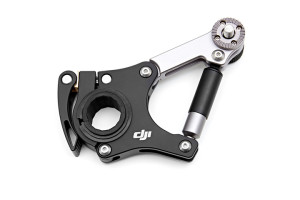
To see what comes with the Osmo check out our DJI Osmo Unboxing.
Here are the videos that were shot with the Osmo:
Video cnet shot with the Osmo:
Official DJI Videos:
Introducing the Osmo
DJI Osmo – Moments
DJI Osmo – Evolution
DJI Osmo – Southwestern United States
DJI Osmo – Peru
DJI Osmo – India
DJI OSMO on set with X5
DJI Osmo Spain
Image credit DJI, header image gizmodo

